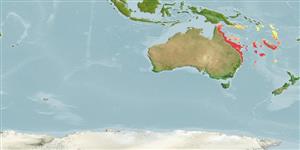>
Eupercaria/misc (Various families in series Eupercaria) >
Lutjanidae (Snappers) > Lutjaninae
Etymology: Lutjanus: Malay, ikan lutjan, name of a fish.
More on author: Castelnau.
Environment: milieu / climate zone / depth range / distribution range
Ecología
marino asociado a arrecife; rango de profundidad ? - 20 m (Ref. 9710). Subtropical; 10°S - 37°S, 143°E - 170°E (Ref. 55)
Western Pacific: restricted to the east coast of Australia and New Caledonia. The main Australian distribution is off southern Queensland between Cape Moreton (about 27°S) and the Capricorn Group(23°S). This species has been usually referred to as Lutjanus amabilis by previous authors.
Length at first maturity / Tamaño / Peso / Age
Maturity: Lm 25.0, range 20 - 30 cm
Max length : 50.0 cm TL macho / no sexado; (Ref. 55); common length : 30.0 cm TL macho / no sexado; (Ref. 55); edad máxima reportada: 40 años (Ref. 2290)
Espinas dorsales (total): 10; Radios blandos dorsales (total): 14; Espinas anales 3; Radios blandos anales: 8. Snout somewhat pointed. Preopercular notch and knob moderately well developed. Scale rows on back rising obliquely above lateral line. Generally pale blue-gray to whitish with suffusion of yellow on upper back. A prominent golden brown stripe, slightly narrower than the eye, runs laterally from the rear edge of the of the opercle to the caudal peduncle.
Adults mainly inhabit coral reefs. Sometimes forming large aggregations around rocky outcrops during daylight hours. They disperse to feed at night (Ref. 9710). Usually marketed fresh.
Life cycle and mating behavior
Madurez | Reproducción | Puesta | Huevos | Fecundidad | Larva
Allen, G.R., 1985. FAO Species Catalogue. Vol. 6. Snappers of the world. An annotated and illustrated catalogue of lutjanid species known to date. FAO Fish. Synop. 125(6):208 p. Rome: FAO. (Ref. 55)
IUCN Red List Status (Ref. 130435)
Threat to humans
Harmless
Human uses
Warning: mysqli::__construct(): (08004/1040): Too many connections in /var/www/html/includes/func_getlabel.php on line 46
Can't connect to MySQL database (fbapp). Errorcode: Too many connections
